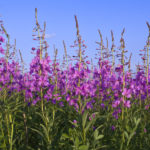27 interesting facts about garlic
 Many doctors recommend eating garlic, in the absence of contraindications, of course. This is an extremely useful product, also notable for the fact that during heat treatment or drying it retains a significant proportion of nutrients. People have known its properties since ancient times, and now garlic in one form or another enters the kitchen of hundreds of different nations.
Many doctors recommend eating garlic, in the absence of contraindications, of course. This is an extremely useful product, also notable for the fact that during heat treatment or drying it retains a significant proportion of nutrients. People have known its properties since ancient times, and now garlic in one form or another enters the kitchen of hundreds of different nations.
Studies show that people who regularly eat it are less prone to heart disease.
In some Asian countries there is such a dessert – black garlic. It is prepared by fermenting its bulbs at high temperature. As a result, it becomes sweet.
Some archaeologists believe that garlic had some mystical or ritual significance in ancient Egypt, because its dried heads were found in the tombs of the pharaohs, in particular, in front of the mummies.
Garlic is a natural natural antibiotic.
It contains more than a hundred different chemical elements.
The ancient Egyptians invariably included garlic in the diet of people engaged in hard physical labor.
The name of the city is “Chicago”, which in the USA, actually simply means “wild garlic” in one of the Indian dialects.
In the first quarter of the 18th century, garlic saved Europe from the plague. As it turned out, being mixed with vinegar, he helped against this disease.
The ancient Romans believed that eating garlic helps develop courage, stamina and courage.
Different peoples used to believe that garlic repels evil spirits, so window and doorways were decorated with garlands from it.
And in fresh, and in any other form, it perfectly kills most bacteria.
The city of Las Pedronieras, in Spain, unofficially is the world capital of garlic.
When the swine flu epidemic broke out in China in 2009, garlic has risen in price 30–40 times, as rumors have it that it helps to cope with this dangerous disease.
Mankind cultivated garlic as early as 3 millennium BC.
For cats and dogs, garlic is dangerous, so give it to your pets is not worth it.
Despite the fact that the beneficial properties of garlic have been known since ancient times, scientists discovered natural antibiotics in it only in the century before last.
In ancient India, garlic was not eaten, but it was widely used as a medicinal plant.
China, South Korea and Italy are firmly in the top three places in the world for garlic consumption per capita.
In Russia, garlic is not officially included in the list of medicinal plants, but everyone knows about its usefulness.
In France, in Gascony, there is a traditional local dish – garlic soup called Touraine.
This plant can grow up to 1.5 meters tall.
Officially, 26 different varieties of it are registered in Russia.
Garlic with a whole onion, not divided into segments, was artificially bred using selection.
The historical homeland of garlic is Central Asia. Most likely, this plant appeared in the territories currently occupied by Tajikistan and Uzbekistan.
The ancestor of garlic is wild spiky onion, from which it originated. Genetically, these two plants are generally identical.
Both the leaves and inflorescences of garlic are quite edible.
In one head of garlic can be from 2 to 50 cloves, depending on the variety of this plant.



























